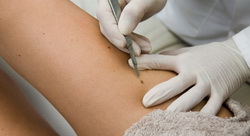Getting rid of unsightly moles on your face or body is a major concern for some self-conscious people. Because of the modern standards in beauty, women as well as men often feel less confident because of skin blemishes. If you suffer from moles whether large or small, there are treatments that you can undergo that will remove the bump of flesh. Dermatologists have a few different methods of getting rid of moles depending on the size and nature of the growth.

Kinds of Mole Removal Techniques
There are three basic kinds of mole removal techniques: laser surgery, excision and cryotherapy. Laser surgery requires the use of a low-intensity laser that literally zaps the mole off of the body while cauterizing the flesh around where the mole had been. This is the quickest and most painless technique which has made it more popular among patients. Excision is the simple process of going into an office, being administered local anesthesia and then having the mole cut off using a surgical lance. This method is subject to infection whereas laser treatment is not – open wounds are much more likely to pick up bacteria or viruses versus cauterized wounds. Lastly, the cryotherapy option also involves having the mole cut but instead of anesthesia, the area of the mole is frozen numb using dry ice. Electrotherapy and radiowave therapy have been proven effective at fighting skin anomalies, too.
Choosing the Best Method
Depending on the size of your mole and whether it is malignant, you may be recommended a particular removal method. The best way to address unusual skin growths is to go to the doctor and have them checked. If you have skin flaps or Nevi moles, (commonly known as beauty marks), these moles are more of a nuisance than a threat. Fading creams are recommended for Nevi moles and skin flaps, so long as they aren’t large, can be either snipped with scissors or shaved off if they’re small. Moles that change color or size over time should be checked immediately – while these signs aren’t definitely cancer, they could be indicators that your mole could be malignant. Surgery is the best option in dealing with a malignant mole. Usually the process involves excavating more tissue than with benign mole removal. Depending on the cancer, this could result in permanent disfigurement. Regardless of what it takes, follow the advice of doctors and specialists but always get a second or even third opinion. By making smart choices early on regarding how you handle cancer, you’ll be increasing your odds of beating it tremendously.
Finding the Right Specialist
By investigating a few offices for second and third opinions, you’ll be more likely to be properly diagnosed. If you’re looking for a specialist, be sure their bedside manner is appropriate and that you trust them. Check their degrees and try finding a specialist with the most experience in your area. As long as you have the right people behind you, your mole removal will be a success.
